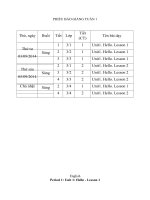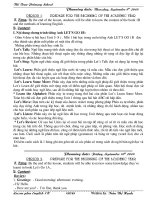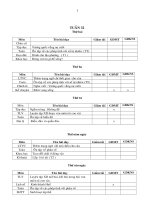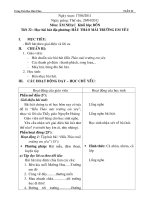Giáo án tiếng Anh lớp 4 tuần 32
Bạn đang xem bản rút gọn của tài liệu. Xem và tải ngay bản đầy đủ của tài liệu tại đây (123.04 KB, 6 trang )
Week: 32
Period: 123
Date of preparation: 16/04/2016
Date of teaching:
UNIT 18: WHAT’S YOUR PHONE NUMBER?
Lesson 3: Part 3-4-5
I. Objectives:
1. Knowledge:
- By the end of the lesson, Ps will be able to ask and answer questions about
someone’s phone number.
2. Skills:
- Develop Ps writing and listening skills
3. Language focus:
- Vocabulary and structures: review
II. Teaching aids:
1. Teacher’s: student’s and teacher’s book, pictures, cassette.
2. Students’: books, notebooks, workbooks.
III. Teaching processes:
Teacher’s activities
Students’ activities
I. Warm up: Read the “I’d like to invite you to my party” - Read the chant
chant
II. New lesson:
4. Read and tick.
- Tell the class that they are going to read the text about
- Listen
Tom’s picnic with his family, decide whether the five
statements are true or false and tick the correct answers.
- Have Ps read the sentences under the text and guess
- Read and guess
which sentence is true and which one is false.
- Ask Ps to do the task.
- Individually
- Get Ps to swap their answers before checking as a class.
- Work in pairs
- Have the whole class read each sentence of the text in
chorus to reinforce their pronunciation
Key: 1.F 2.T 3.F 4.T 5.T
5. Let’s write.
- Tell Ps that they are going to complete a short paragraph - Listen
about themselves.
- Have discuss what they are going to write in the gaps of
- Work in groups
the sentences. Focus them on where they usually go on
Sundays and what they want to do there.
- Ask Ps to do the task. T goes around and offers help.
- Individually
- Get Ps to swap their answers before checking as a class.
- Work in pairs
6. Project
- Tell Ps that they are going to ask four classmates for their - Listen
phone numbers, and then report the results to the class.
- Give each P a card and ask them to copy the table from
- Do as directed
the P’s book on their cards.
- Give Ps time to ask their classmates for their phone
- Individually
numbers and write them down.
- Have Ps look at the table and tell the class their
- Present
classmates’ phone numbers.
III. Consolidation
- Summary the lesson
- Listen
IV. Homework
- Do exercises in workbook, prepare the next period.
- Remember
*************************************************************************
Week: 32
Period: 124
Date of preparation: 16/04/2016
Date of teaching:
UNIT 19: WHAT ANIMAL DO YOU WANT TO SEE?
Lesson 1: 1-2
I. Objectives:
1. Knowledge:
- By the end of the lesson, Ps will be able to ask and answer questions about
someone’s desire, using What animal do you want to see? I want to see ...
2. Skills:
- Develop Ps speaking and listening skills.
3. Language focus:
- Vocabulary: phone number, mobile phone, present.
- Structures: What animal do you want to see?- I want to see + name of animal.
II. Teaching aids:
1. Teacher’s: student’s and teacher’s book, pictures, cassette.
2. Students’: books, notebooks, workbooks.
III. Teaching processes:
Teacher’s activities
I. Warm up: Play “jumbled letters” game
II. New lesson:
1. Look, listen and repeat.
- Tell the class that they are going to read a story in
which Mai and Nam visit the zoo.
- Ask Ps to look at 4 pictures on page 58 and ask:
+ Who are they?
+ Where are they?
+ And What are they talking about?
- Teach some new words:
wonderful: quá tuyệt vời
monkey: con khỉ
+ Teacher read first as a model and ask the Ps to repeat
+ Have the Ps repeat in groups and individuals
- Open the tape and have the Ps listen the sound of the
words.
- Play the recording a few times for pupils to listen and
repeat. Do choral and individual repetition, pointing to
the characters speaking
- Instruct Ps to translate the dialogue into Vietnamese.
2. Point and say
- Tell Ps that they are going to practice asking and
answering questions about what animal someone wants
to see, using What animal do you want to see? I want
to see ...
- Teach some new words:
kangaroo: con chuột túi
crocodile: con cá sấu
tiger: con hổ
elephant: con voi
+ Teacher read first as a model and ask the Ps to repeat
+ Have the Ps repeat in groups and individuals
- Instruct how to ask and answer questions about what
animal someone wants to see
Students’ activities
- Play the game
- Listen
- Look and answer:
+ They are Nam and Mai.
+ They’re in the zoo.
+ They are talking about the
animals.
- Listen and copy
+ Listen and repeat
+ Groups, individuals
- Listen
- Listen and repeat
- Do as directed
- Listen
- Listen and copy
+ Listen and repeat
+ Groups, individuals
- Listen and copy
- Ask: What animal do you want to see?
- Answer: I want to see + name of animal.
- T practices as a model and ask Ps to practice in
- Do as directed
choral, groups and pairs. Correct Ps’ error
pronunciation
Key:
a. What animal do you want to see?
I want to see kangaroos.
b. What animal do you want to see?
I want to see crocodiles.
c. What animal do you want to see?
I want to see tigers.
d. What animal do you want to see?
I want to see elephants.
* Work in pairs. Ask your partners what animal
they want to see at the zoo.
- Tell Ps that they are going to practice asking and
- Listen to the teacher
answering questions about what animal someone wants
*************************************************************************
Week: 32
Period: 125
Date of preparation: 16/04/2016
Date of teaching:
UNIT 19: WHAT ANIMAL DO YOU WANT TO SEE?
Lesson 1: 3-4-5
I. Objectives:
1. Knowledge:
- By the end of the lesson Ps will be able to ask and answer question about
someone’s desire.
2. Skills:
- Develop Ps speaking and listening skills
3. Language focus:
- Vocabulary and structures: review
II. Teaching aids:
1. Teacher’s: student’s and teacher’s book, pictures, cassette.
2. Students’: books, notebooks, workbooks.
III. Teaching processes:
Teacher’s activities
Students’ activities
I. Warm up: Play the game “jumbled letters”
- Play the game
II. New lesson:
3. Listen and match.
- Tell the class that they are going to listen to three
- Listen
dialogues about what animals Tony, Tom and Linda want
to see and match each character to the correct picture.
- Have Ps look at the pictures to identify the characters and - Look and identify
the zoo animals.
- Open the tape and have Ps listen the sound of the words
- Listen
- Turn on the tape 2 times and ask Ps to listen and match.
- Listen and match
- Get Ps to swap their answers before checking as a class.
- Work in pairs
Key: 1.c 2.a 3.b
4. Look and write
- Tell Ps that they are going to write what the children want - Listen to the teacher
to see, using the picture cues.
- Have them look at the four pictures to identify what
- Do as directed
animal the children want to see in each picture. Then ask
them to read the questions. Draw their attention to the
different pronouns he, she and they in the questions. After
that, have them write the answers in complete sentences.
- Give Ps time to do the task.
- Individually
- Get them to swap their answers before checking as a
- Work in pairs
class.
- Have the whole class read the sentences chorally to
- The whole class read
reinforce their pronunciation.
aloud
Key: 1.He wants to see crocodiles.
2.She wants to see monkeys.
3.They want to see kangaroos.
4.They want to see tigers.
5. Let’s play.
- Tell Ps that they are going to play the game Charades.
- Listen
- Introduce how to play the game: show a P the name of a
- Listen
zoo animal. P must act out the animal for the rest of the
class to guess. The quickest P to say the name of the animal
gets a point. Then select another P to mime another animal.
The P who gets the most points at the end of the game is
the winner.
- Have Ps play the game.
- Play the game
- Give comments.
III. Consolidation
- Retell the content of the lesson.
- Retell
IV. Homework
- Do exercises in the workbook. Prepare the next period.
- Remember
*************************************************************************
Week: 32
Period: 126
Date of preparation: 16/04/2016
Date of teaching:
UNIT 19: WHAT ANIMAL DO YOU WANT TO SEE?
Lesson 2: 1-2-3
I. Objectives:
1. Knowledge:
- By the end of the lesson, Ps will be able to express reasons, using I like ...
because .../ I don’t like ... because ...
2. Skills:
- Develop Ps speaking and listening skills.
3. Language focus:
- Vocabulary: speak, free, go for a picnic, ask, call back, go for a walk, go fishing,
go skating.
- Structures: Would you like to + V-activity?. - I’d love to. / Sorry, I can’t.
II. Teaching aids:
1. Teacher’s: student’s and teacher’s book, pictures, cassette.
2. Students’: books, notebooks, workbooks.
III. Teaching processes:
Teacher’s activities
Students’ activities
I. Warm up: Play the game Palmanism
- Play the game
II. New lesson:
1. Look, listen and repeat
- Tell the class that they are going to read a conversation
- A pair of yellow trousers.
in which Linda and Nam ask and answer questions about
zoo animals.
- Ask Ps to look at 4 pictures to identify the context in
- Look at 4 pictures and
which the languages is used. Ask Ps questions:
answer:
+ Who are they?
+ They are Linda and Nam.
+ Where are they?
+ They are in the zoo.
+ And What are they talking about?
+ They are talking about
- Teach some new words:
funny: buồn cười
scary: làm sợ hãi
+ Teacher read first as a model and ask the Ss to repeat
+ Have the Ps repeat in groups and individuals
- Open the tape and have the Ps listen the sound of the
words.
- Play the recording a few times for pupils to listen and
repeat. Do choral and individual repetition, pointing to the
characters speaking
- Instruct Ps to translate the dialogue into Vietnamese.
2. Point and say
- Tell Ps that they are going to practice expressing reasons
why they like/ do not like some animals, using I like/
don’t like ... because ...
- Teach some new words:
zebra: ngựa vằn
fast: nhanh
+ Teacher read first as a model and ask the Ss to repeat
+ Have the Ps repeat in groups and individuals
- Instruct how to express reasons.
animals.
- Listen and copy
+ Listen and repeat
+ Groups, individuals
- Listen
- Listen and repeat
- Do as directed
- Listen
- Listen and copy
+ Listen and repeat
+ Groups, individuals
- Listen and copy
+ Like: I like + name of animals + because + they are +
adj
+ Don’t like: I don’t like + name of animals + because +
they are + adj.
- T practices as a model and ask Ps to practice in choral,
groups and pairs. Correct Ps’ error pronunciation
Key:
a. I don’t like tigers because they are scary.
I don’t like crocodiles because they are scary.
b. I don’t like bears because they are big.
I don’t like elephants because they are big.
c. I like zebras because they are beautiful.
d. I like kangaroos because they are fast.
3. Let’s talk:
- Tell Ps that they are going to revise what they have
learnt in Lessons 1 and 2, using facts about themselves.
- Model the task with one P. (Ex: T asks: What animal do
you want to see? P answers: I want to see zebras. I like
zebras because they’re beautiful. I don’t like crocodiles
because they’re scary.) Put the sentences on the board
and do choral and individual repetition.
- Ask them to work in pairs
- Select some pairs to role-play the dialogue in front of
the class.
III. Consolidation:
- Summary the lesson
IV. Homework:
- Do as directed
- Listen
- One pupil
- Work in pairs
- Some pairs perform in
front of class
- Listen to the teacher
- Do exercises in workbook, learn by heart the new
words
- Remember









